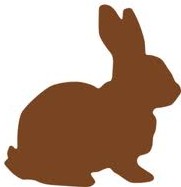That’s The Way The Easter Bunny Goes – Cluas i ndiaidh Cluaise (using the Irish verb “to eat”)! Posted by róislín on Apr 9, 2010 in Irish Language
(le Róislín)
Some of you might still have your chocolate Easter bunnies, or part of them left. To celebrate the gradual eating of such chocolate bunnies, which usually starts with the cluas (ear), let’s continue our relative clause series with the irregular verb “ith” (eat). As you’ll see, some forms of “ith” look regular, such as “ithim” (I eat) and “d’ith mé” (I ate). You’ll see the irregular stem (íos-) in the future-tense form, though (íosfaidh mé / I will eat).
If we were including the oft-dreaded modh coinníollach in this series, you’d also see the irregular stem there (d’íosfainn, I would eat), but the good news is that we haven’t been including the conditional mood in this series so far, so I don’t see any reason to start now! Our main purpose, remember, is to contrast how the direct relative clauses use séimhiú (b->bh, srl.) and the indirect relative clauses use urú (b->mb, srl.). Since today’s verb (ith) begins with a vowel, we won’t have séimhiú as such, but we will introduce the particles “d’” and “ar” for the past-tense examples. We’ll also have eclipsis of the vowel by prefixing “n-” as in “a n-itheann.”
So here goes, and so goes the coinín seacláide (chocolate bunny)! We’ll start with the simple sentences (no relative clause), then do the direct relative, and then the indirect, for present, past, and future. We’ll also go partly through the anatomy of chocolate rabbits!
1) An aimsir láithreach: Itheann an páiste cluas an choinín seacláide (The child eats the ear of the chocolate rabbit). An itheann an páiste cluas an choinín seacláide?
Direct relative: Seo é an páiste a itheann cluas eile an choinín seacláide (This is the child who eats the other ear of the chocolate rabbit).
Indirect relative: Seo é an páiste a n-itheann a dheirfiúr súile an choinín seacláide (This is the child whose sister eats the eyes of the chocolate rabbit). NB: this sentence implies that the child in the main clause is a boy; if the child in the main clause is female, we’d say “a deirfiúr.”
2) An aimsir chaite: D’ith an páiste ruball an choinín seacláide (The child ate the tail of the chocolate rabbit). Ar ith an páiste ruball an choinín seacláide?
Direct: Seo é an páiste a d’ith lámhóideanna an choinín seacláide (This is the child who ate the forelegs of the chocolate rabbit).
Indirect: Seo é an páiste ar ith a dheartháir cosa deiridh an choinín seacláide (This is the child whose brother ate the hind legs of the chocolate rabbit). NB as above, with “whose brother” becoming “a deartháir” if the first child is a girl. The word “é” would also change to “í” in that case.
3) An aimsir fháistineach: Íosfaidh an páiste guaillí an choinín seacláide (The child will eat the shoulders of the chocolate rabbit). An íosfaidh an páiste guaillí an choinín seacláide?
Direct: Seo é an páiste a íosfaidh cabhail an choinín seacláide (This is the child who will eat the torso of the chocolate rabbit).
Indirect: Seo é an páiste a n-íosfaidh a chol ceathar na blúirí seacláide atá fágtha sa bhosca a raibh an coinín seacláide ann. (or “a col ceathar” as per the NBs above, if the first child is female; the word “é” would also change to “í” in that case.)
“A thiarcais!” you might exclaim, checking out that last sentence, which actually has three relative clauses (not unusual for an Irish sentence). Here’s the translation:
This is the child whose cousin will eat the crumbs of chocolate that are left in the box that the chocolate rabbit was in.
One last point you may have noticed: “the ear of the chocolate bunny” is “cluas an choinín seacláide,” with séimhiú on the word “coinín,” to indicate possession. Also, the definite article “an” in the middle of the phrase applies to both “ear” and “bunny.” In Irish, the definite article is only used once per phrase showing possession (unlike English, which can say “the ear of the bunny”). And yes, at some point we could discuss why English has two systems for showing possession (the ear of the bunny, the bunny’s ear) and how Irish simply (!) uses an tuiseal ginideach for both structures, but, mh’anam, sin ábhar blag eile!
Nótaí: a thiarcais! [uh HEER-kish] my goodness!; cluas [KLOO-uss] ear; d’íosfainn [DJEESS-hin] I would eat; íosfaidh [EESS-hee] will eat; ith [ih, silent “t”]; itheann [IH-hun, silent “t”] eats; seacláide [SHAK-LAWDJ-eh] of chocolate
P.S. Perhaps if Mike Tyson could have read this blog in advance of the famous “Bite Fight,” all the hullabaloo about that ear-biting incident could have been avoided. Surely “cluas an choinín seacláide” would have been a better choice!

Build vocabulary, practice pronunciation, and more with Transparent Language Online. Available anytime, anywhere, on any device.





Comments:
Mise Áine:
Maith thú!
Ní dóigh liomn go bhfuil Gaeilge ag Mike Tyson, a Róislín…:-)
róislín:
@Mise Áine GRMAgat, a Áine. Nóta cineálta eile!
Agus tá mé cinnte go bhfuil an ceart agat nach bhfuil Gaeilge ag Mícheál an Aithinne Theinteach. Sin an téarma Gaeilge is cosúla dá shloinne a bhfuil mé ábalta teacht air. De réir an chuid is mó de na ginealeolaithe tagann an sloinne Tyson ón tSeanFhraincis ’tison’ (firebrand). Comhtharlú suimiúil! Ach is dócha nach bhfuil an tSeanFhraincis ag mo dhuine ach oiread!
Mise Áine:
Ní dóigh liom go bhfuil…:-)